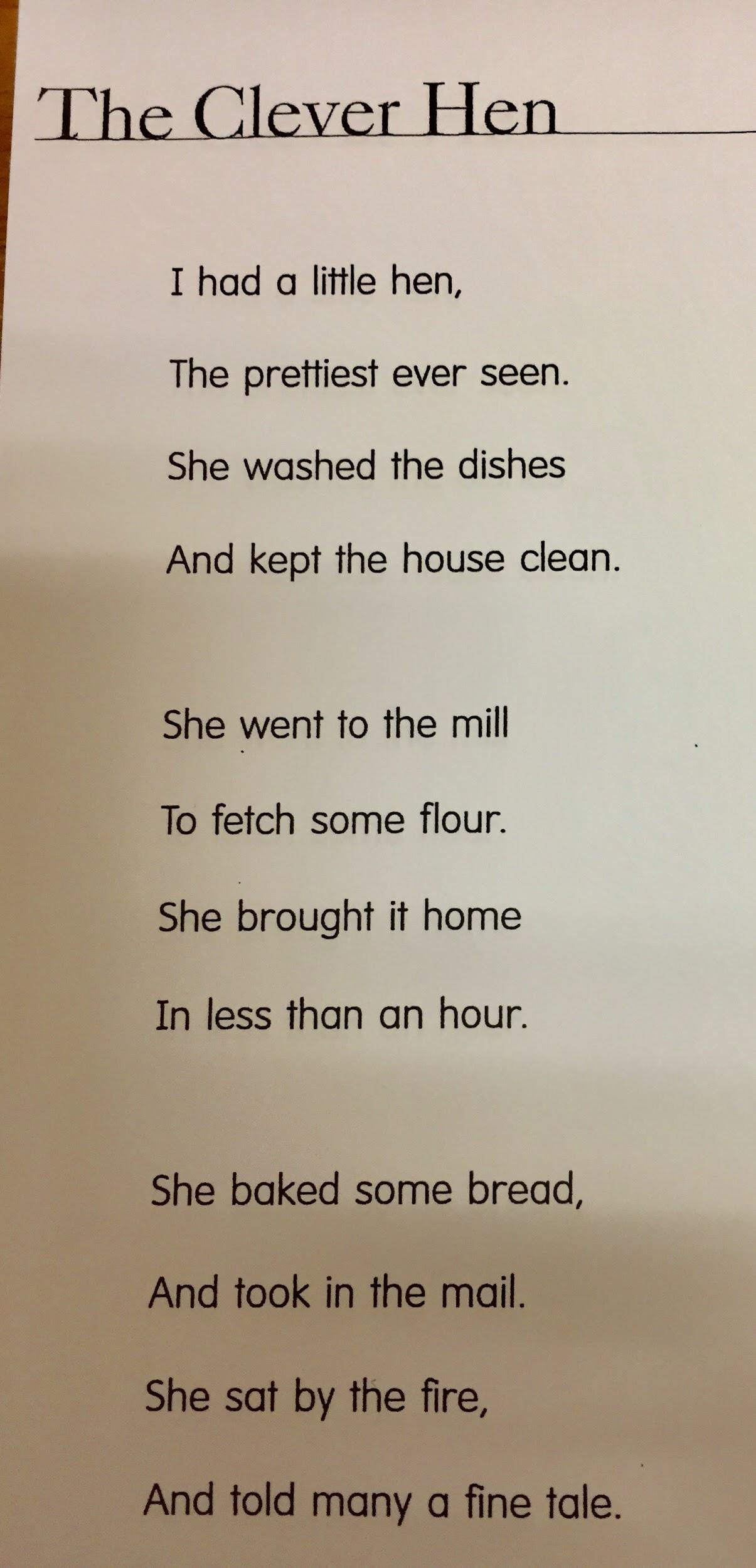Goal:
Students will understand the concept of rhyming words and how they have endings that sound the same.
Specific Learning Objectives:
- Students will learn how to use words from the story.
- Students will learn how to notice words that rhyme.
- Students will be able to describe how some words can be a saying that has a different meaning.
- Students will learn how to read fluently in front of others with confidence.
Introduction/ Hook:
Before reading the poem we watched a video on how a water mill makes flour. We discussed the process of how flour is made. I also put up a picture of a hen without a label and asked if they knew what it was. We then thought out loud about what a hen and a mill might be doing in a story or a poem.
Day 1
Today we begin by having students copy a new poem called, The Clever Hen, into their journal at home. We read through the poem one time to get a feel for it. I had a few slides that would show them what some of the unknown words would be. We started with the word “mill”. We looked at a flower mill that was used to ground wheat to make flour. We discussed the wind powered and water powered wheels. I showed students the process of making bread which was a central theme of the poem. Utilizing the pictures we also made some conclusions about what the character was doing in the sequence of events in the poem. The last thing we discussed was the phrase “told many a fine tail”. Students discussed what that meant in zoom breakout groups and how the word tail was different from the word tale. After we discovered that the saying meant it was a story or a white lie we came up with fine tales that fit the description. Upon finishing the vocabulary and comprehension discussion we read the poem through using echo reading. I would say a line and they would repeat it the way I said it. After we did this a few times we talked about words that rhymed. We looked at the words “seen“ and “clean“. I asked what was similar about the two words and why they sounded like. Students came up with the fact that the two words did not have the same beginning sounds but had the same ending sound and they highlighted them in yellow crayon at home. We then looked at the other rhyming words and discovered that the same words have the same sound as well as the same spellings in their endings whereas others could have the same sound but different spellings. Students were allowed to practice reading the poem with a partner in a zoom breakout group for a few minutes. They took turns reading when they got back to the whole group. Again partner work really paid off because it allowed kids to feel safe and connected.
Day 2
During small group Zoom meetings I listened to students practice reading the poem. More advanced students I had act it out or say it in a different voice. During the whole group Zoom we had Poetry Jam. Kids took turns reading the poem using a different voice and adding movements.

Assessment
Student’s read aloud the poem watching for voice and fluency as well as tempo and rhythm. Pictures of poetry journal with highlighted rhyming words.
Appropriateness of Activities
The lesson presented was appropriate for this age group. It translated effectively online using YouTube videos and by activating knowledge about certain words prior to reading the poem. Poetry Jam made the lesson fun and gave students the opportunity to engage in public speaking in a safe environment.
Correlation of Activities to the Seminar
This activity worked well when utilizing small groups on Zoom. Students felt comfortable when reading with a partner and then reading in front of the whole class. Video taping some of the better and more creative examples and posting them on Bloomz was a good way of modeling poetry reading.
Self Evaluation
Rhyming and poetry are so much fun to teach. It illustrates so many aspects of reading and writing. This lesson was successful because of the performance piece. Allowing students to read with different voices is engaging and fun. I need to be mindful of how much I try to teach in a single lesson. I sometimes include too many focus points so the main idea can get lost if I am not careful.
